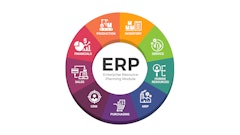New version brings together traditional, emerging technologies to eliminate multiple translation engines, help improve supply chain performance
Gaithersburg, MD — July 18, 2005 — B2B connectivity solution provider GXS has rolled out a new version of its data transformation solution, offering a tool with both native electronic data interchange (EDI) and native XML available through a single user interface and management console, eliminating the need for multiple translation engines.
Version 5.0 of GXS' Application Integrator (AI) is intended to simplify data integration and mapping by allowing businesses to communicate with any trading partner using any major industry standard. More than 600 customers in 30 countries across the Americas, Europe and Asia-Pacific currently use AI for their B2B e-commerce transactions, according to GXS.
AI 5.0 provides the ability to embed business rules in XML maps, enabling the incorporation of business logic within the translation map. In addition, the solution now provides control of modeling and data management processes, featuring the ability to support XSL map development with third-party mapping tools already deployed. This helps eliminate re-mapping, thus reducing the likelihood of errors in modeling, helping to reduce end-user training time and expense, and freeing up IT staff to perform other activities.
AI supports a variety of document standards, such as XML, ANSI EDI, EDIFACT, RosettaNet, CIDX and PIDX, making it applicable for customers in a variety of industries, including consumer products, automotive, high tech, transportation and telecommunications. GXS also said it supports communication protocols such as AS2, FTP, Web services and the Zengen protocol frequently used in Japan.
GXS also said that AI is the data translation engine embedded in the GXS Trading Grid, which is a global integration services platform intended to enable and streamline cross-enterprise business processes. As a result, maps developed in AI are compatible and transferable between software implementations on a customers premise and hosted implementations on the Trading Grid, helping to provide flexibility and investment protection for GXS customers, according to the solution provider.
Finally, AI 5.0's new version control system retains a historical record of all changes to maps, allowing older maps to be reviewed on-demand for auditing or problem resolution. GXS said that many of its clients use AI to translate and validate financial documents, such as electronic invoices, payment notifications and remittance advices. These new features could help companies deal with new government mandates — such as Sarbanes Oxley and HIPAA — requiring enterprises to track and retain detailed records of transactions and business exchanges.
Additional Articles of Interest
— Benchmarking is one way to improve your supply chain's competitive advantage. For easy guidelines that will help overcome any challenges benchmarking may present, read "Standardizing Benchmarking to Achieve Results."
— Hard data and sophisticated planning are key when goods and materials start flowing upstream through the reverse supply chain. Read more in "Meeting the Reverse Logistics Challenge" in the June/July 2005 issue of Supply & Demand Chain Executive.
— Words of wisdom from one university professor go a long way to help business students excel in supply chain management. Read "Interview with Dr. John T. Mentzer: Teaching Supply Chain" in the June/July 2005 issue of Supply & Demand Chain Executive.
Gaithersburg, MD — July 18, 2005 — B2B connectivity solution provider GXS has rolled out a new version of its data transformation solution, offering a tool with both native electronic data interchange (EDI) and native XML available through a single user interface and management console, eliminating the need for multiple translation engines.
Version 5.0 of GXS' Application Integrator (AI) is intended to simplify data integration and mapping by allowing businesses to communicate with any trading partner using any major industry standard. More than 600 customers in 30 countries across the Americas, Europe and Asia-Pacific currently use AI for their B2B e-commerce transactions, according to GXS.
AI 5.0 provides the ability to embed business rules in XML maps, enabling the incorporation of business logic within the translation map. In addition, the solution now provides control of modeling and data management processes, featuring the ability to support XSL map development with third-party mapping tools already deployed. This helps eliminate re-mapping, thus reducing the likelihood of errors in modeling, helping to reduce end-user training time and expense, and freeing up IT staff to perform other activities.
AI supports a variety of document standards, such as XML, ANSI EDI, EDIFACT, RosettaNet, CIDX and PIDX, making it applicable for customers in a variety of industries, including consumer products, automotive, high tech, transportation and telecommunications. GXS also said it supports communication protocols such as AS2, FTP, Web services and the Zengen protocol frequently used in Japan.
GXS also said that AI is the data translation engine embedded in the GXS Trading Grid, which is a global integration services platform intended to enable and streamline cross-enterprise business processes. As a result, maps developed in AI are compatible and transferable between software implementations on a customers premise and hosted implementations on the Trading Grid, helping to provide flexibility and investment protection for GXS customers, according to the solution provider.
Finally, AI 5.0's new version control system retains a historical record of all changes to maps, allowing older maps to be reviewed on-demand for auditing or problem resolution. GXS said that many of its clients use AI to translate and validate financial documents, such as electronic invoices, payment notifications and remittance advices. These new features could help companies deal with new government mandates — such as Sarbanes Oxley and HIPAA — requiring enterprises to track and retain detailed records of transactions and business exchanges.
Additional Articles of Interest
— Benchmarking is one way to improve your supply chain's competitive advantage. For easy guidelines that will help overcome any challenges benchmarking may present, read "Standardizing Benchmarking to Achieve Results."
— Hard data and sophisticated planning are key when goods and materials start flowing upstream through the reverse supply chain. Read more in "Meeting the Reverse Logistics Challenge" in the June/July 2005 issue of Supply & Demand Chain Executive.
— Words of wisdom from one university professor go a long way to help business students excel in supply chain management. Read "Interview with Dr. John T. Mentzer: Teaching Supply Chain" in the June/July 2005 issue of Supply & Demand Chain Executive.
- More articles about GXS.


















